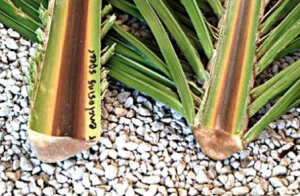

Left: Late symptoms of mystery disease, note how the fronds do not break, nor do they hang parallel to the trunk. Several landscape managers reported that the palms were green one week and then it was as if they had been freeze-dried overnight. Photo by Scott Lowery. Right: Brown-red stripe on outside and discoloration of inside area is indicative of this new disease. Photo by Dr. Monica Elliott, U.F., Ft. Lauderdale.
May 2005
Several communities in Collier and Lee counties have lost 10 to 15 queen palms in the last 8 months. These include: Calusa Bay, Pelican Landing and Colonade. Only queen palms have been affected. Since December 2004, Dr. Monica Elliott, plant pathologist with the University of Florida in Ft. Lauderdale, has examined queen palms from Tampa, Orlando, West Palm Beach and Naples. All sites have had a similar sequence of palm decline. Symptoms were first observed a year or two ago on established palms, but less than 1% of the palms were affected, so not too much was thought about it. Some communities have now lost up to 10% of their queen palms. Dr. Elliott released a May 5 update at:
http://flrec.ifas.ufl.edu/Hort/ Plant_pathology/plant.htm.
Dr. Elliott states: “The symptoms are as follows. The lowest (oldest) 2-3 leaves turn brown, but do not break or hang down. The next 2-3 youngest leaves in the canopy will turn varying shades of yellow. The yellowing leaf symptoms alone are not indicative of the disease as these symptoms would be similar for natural senescence, especially when potassium deficiency is present. What makes the disease different from natural senescence is that usually within two months of initial symptoms, the entire canopy has turned brown, as if freeze-dried in place.
The leaves do not break nor do they hang limply parallel to the trunk, they simply turn brown in place within the canopy. Closer examination of the yellowing leaves and the next green leaf in the canopy should reveal what we believe is the initial target of the pathogen, the leaf petiole at the point where it is bending out of the canopy. We have observed initial areas of discoloration (a brownish-red ‘streak’) at this point that…….(progresses in both directions) on the petiole. The petiole is not rotted, but simply discolored. Cross-sections through the petiole reveal internal discoloration. Cross- sections must be done with a sharp saw and not with a crushing tool such as a clipper, as the crushing motion will discolor tissue also. Leaflet tips, even on lower green leaves, exhibit drought symptoms. The bud of the palm is not killed until sometime (probably a week or so) after the canopy turns brown. When cross-sections are made through the crown of a dead queen palm, the bud is still clean and white, but older leaf and inflorescence bases are discolored and usually rotted. The symptoms and their development suggest a pathogen, probably fungal, that is producing a toxin. The pathogen is unknown at this time. We have isolated “potential” pathogens and will shortly be conducting pathogenicity tests.”
Since we do not know which pathogen(s) may be causing the disease, cultural or chemical management recommendations cannot be made.
Unfortunately, quite a few communities have a monoculture of queen palms. These palms require frequent pruning with their constant fruit and clinging dead fronds. Other problems that frequently kill the palms include: ganoderma butt rot disease, potassium deficiency, frizzletop (a manganese deficiency) and boron deficiency. Do not replant with queen palms until more is known about this disease. Remember to diversify your landscape with several species of featured trees and palms so that if an epidemic hits, your landscape won’t be devastated.
See: http://collier.ifas.ufl.edu/Horticulture/queenpalm.htm
Doug Caldwell is the landscape horticulture extension educator with Collier County. For more information on home gardening, contact the University of Florida Collier County Extension office. Extension programs are open to all persons without regard to race, color, creed, sex, handicap or national origin. Visit our website for more horticulture information: http://collier.ifas.ufl.edu/ .
 0
0
